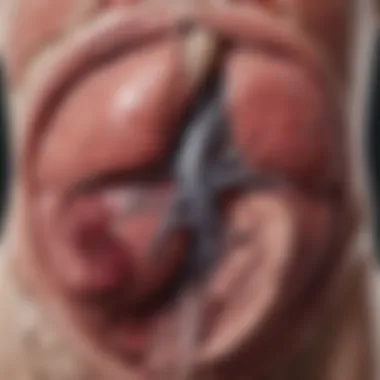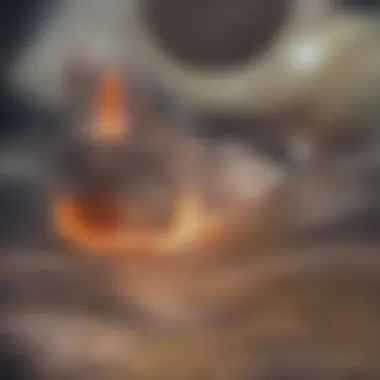Understanding the Liver's Anatomical Context


Intro
The human liver is a vital organ, engaging in numerous essential functions vital for maintaining overall health. Understanding its location within the body provides insight into its anatomical significance. Positioned primarily in the right upper quadrant of the abdomen, the liver is closely associated with several other critical structures. This article aims to illuminate the liver's precise anatomical context and highlight its interrelation with surrounding organs, thus typifying its role in the digestive and metabolic processes.
The liver, weighing approximately 1.5 kilograms in an adult, is the body's largest solid organ. It sits beneath the diaphragm, primarily taking up space in the right hypochondriac region while extending into the epigastric region. Delineating its location is not just a matter of anatomical mapping; it has clinical implications that are particularly significant in understanding various diseases and surgical procedures.
Summary of Objectives
This article delves into the anatomical location of the liver, examining its placement concerning adjacent organs. It offers a detailed assessment of factors that influence liver positioning including the diaphragm, lungs, and stomach. The objective is to furnish readers with a well-rounded understanding of the liver's anatomical context and its functional implications.
Importance of the Research
Recognizing the anatomical context of the liver plays a crucial role in clinical medicine, diagnostics, and surgical interventions. Variations in liver position due to anatomical differences among individuals can influence procedures such as liver transplants and the management of liver diseases. Therefore, research into liver anatomy is integral to enhancing clinical outcomes.
Results and Discussion
Presentation of Findings
The human liver’s position can vary among individuals; however, its anterior surface is typically convex while its posterior surface is relatively flat. The right lobe is larger than the left, which contributes to the asymmetrical view of the liver in imaging studies. It is bordered superiorly by the diaphragm and has direct relationships with the right kidney, gallbladder, and portions of the small intestine.
The liver is enveloped in a fibrous capsule called Glisson's capsule, providing structural integrity. It is also notable that the liver exhibits a dual blood supply, receiving blood from both the hepatic artery and the portal vein. This demarcation is essential for its ability to filter blood and process nutrients absorbed from the digestive tract.
Implications of Results
Understanding the liver's anatomical location not only enhances knowledge of its function but also informs clinical practices. Surgeons must have a clear grasp of liver anatomy to navigate procedures that may require resection or transplantation. In addition, when evaluating liver diseases, imaging techniques must consider the organ's location to accurately assess pathologies.
"The liver plays a central role in metabolism, detoxification, and bile production, warranting a detailed understanding of its location within the body for effective medical care."
Furthermore, variations in liver placement can have implications in pediatric and geriatric populations, who may exhibit anatomical differences. For instance, the liver size and position change with age, potentially affecting how diseases manifest and are treated.
In summary, the anatomical context of the liver is both complex and critical. Understanding its relationships with surrounding organs provides insights essential to various medical fields. This discussion offers a stepping stone for further exploration into liver functionality and pathology.
Intro to the Human Liver
The human liver plays a crucial role in maintaining bodily functions. Understanding its anatomy is vital for various fields, including medicine, nutrition, and physiology. This section will establish the foundational knowledge of the liver, which is necessary for interpreting its functions and location within the human body.
Overview of the Liver's Functions
The liver is a multifaceted organ that performs several essential functions. Primarily, it is involved in the metabolism of nutrients. After food is consumed, nutrients are absorbed into the bloodstream through the intestines. The liver processes these nutrients, converting them into forms that the body can utilize.
It also plays a crucial role in detoxification. The liver filters toxins from the blood, breaking them down and removing them from the body. This action is vital for maintaining overall health. Additionally, the liver produces bile, which aids in digestion by emulsifying fats, enhancing fat absorption in the intestine.
Moreover, the liver is responsible for storing vitamins and minerals, including iron and Vitamin A. It also regulates blood glucose levels, a precise balance of energy supply for bodily functions. The presence of numerous cells known as hepatocytes allows the liver to manage these complex tasks efficiently.
Importance of Understanding Liver Location
Knowing the anatomical placement of the liver is significant for both health assessments and surgical interventions. The liver is situated primarily in the right upper quadrant of the abdomen. Its positioning influences its interactions with adjacent organs, which can have direct implications for disease diagnosis and treatment.
The liver's proximity to the diaphragm, stomach, gallbladder, and duodenum also affects its anatomical relationships. These relationships are important, especially when considering conditions such as liver diseases, where swelling or damage may cause changes in location or size.


"The liver's anatomical context can significantly impact clinical evaluations and interventions. Understanding its location informs various medical practices."
Overall, a comprehensive understanding of the liver's location and functions not only enhances academic knowledge but also enriches practical applications in the medical field.
Anatomical Location of the Liver
Understanding the anatomical location of the liver is fundamental in grasping its function and involvement in various bodily processes. This section will elucidate the liver's position within the abdominal cavity and its relationship to nearby structures, serving both medical and educational purposes. The precise placement of the liver affects not only its operation but also its interaction with surrounding organs, which can illuminate certain clinical implications.
Position in the Abdominal Cavity
The human liver is primarily situated in the right upper quadrant of the abdominal cavity. It occupies a significant area below the diaphragm and extends across the midline toward the left side. The liver's orientation is slightly angled, with the anterior surface facing forward and the posterior surface directed toward the back. This unique positioning enables the liver to efficiently perform its metabolic and detoxification roles.
The anatomical proximity of the liver to the diaphragm is notable. The diaphragm, a muscle that aids in respiration, creates a separation between the thoracic cavity and the abdominal cavity. This relationship is crucial as the liver must be adequately ventilated while remaining anchored in place.
Relation to Nearby Structures
The liver does not function in isolation; rather, it exists in a complex network interfaced with adjacent organs. Understanding these relationships provides insights into both normal physiology and potential pathologies.
Diaphragm
The diaphragm's placement above the liver serves as a protective barrier while also facilitating the liver's blood supply. Positioned directly superior, the diaphragm allows for the hepatic blood vessels to efficiently carry blood to and from the liver. Additionally, the movement of the diaphragm during breathing impacts liver positioning.
However, any significant swelling or enlargement of the liver can exert pressure on the diaphragm, potentially leading to respiratory issues. Thus, the relation between the liver and diaphragm proves essential for both respiratory function and liver health.
Stomach
Located anterior to the liver, the stomach is another key organ in this anatomical context. The liver's size and position shield the stomach from direct trauma. Furthermore, the conversion of food into chyme within the stomach is closely tied to the liver's ability to process nutrients.
The location of the stomach allows for efficient transfer of digested material into the duodenum, where the liver’s bile salts assist in fat emulsification. However, conditions such as gastric reflux may affect the liver indirectly through altered digestive processes.
Gallbladder
The gallbladder, situated beneath the liver, plays a supportive role in fat digestion. It stores bile produced by the liver, releasing it into the duodenum as needed. The close relationship does facilitate efficient digest, but any dysfunction in the gallbladder can have repercussions for liver health. For instance, gallstones can obstruct bile flow, resulting in liver inflammation.
Duodenum
Finally, the duodenum, the first part of the small intestine, is positioned directly below the liver and is critical in digestion. Here, the liver's bile is introduced, complementing digestive action. The close anatomical relationship with the duodenum highlights the liver’s pivotal role in digestion and nutrient absorption.
Liver Lobes and Segmentation
The liver is a complex organ that can be divided into distinct lobes and segments, which is crucial for understanding its structure and function. This segmentation not only aids in identifying various pathologies but also has significant implications in surgical procedures. Each lobe has a unique role in liver physiology and contributes to the organ’s overall functionality.
Understanding the lobular structure of the liver provides insights into how blood flow and bile production are organized. This knowledge is essential for medical professionals when diagnosing liver diseases or planning interventions.
Right and Left Lobes
The liver consists of two primary lobes: the right and left lobes, which are separated by the falciform ligament. The right lobe is significantly larger than the left, making up approximately 70% of the liver's total mass. The right lobe's extensive size allows for various functions, including detoxification processes, bile production, and glucose metabolism.
The left lobe, though smaller, plays an indispensable role in similar metabolic processes. Its size does not diminish its importance, especially in terms of blood flow and nutrient processing. Understanding the distinct contributions of both lobes helps in grasping how the liver operates within the complex network of human metabolism.
Caudate and Quadrate Lobes


In addition to the right and left lobes, the liver contains caudate and quadrate lobes. These lobes create a more intricate anatomy which can influence clinical practices. The caudate lobe is positioned posteriorly and has a unique vascular supply from both the hepatic artery and the portal vein. This lobe is often described as having a role in the regulation of blood coagulation and clearance of bacteria from the bloodstream.
On the other hand, the quadrate lobe is situated anteriorly and plays a role in bile secretion. Specifically, it is closely linked to the gallbladder, which is essential for digestion. Highlighting these specific lobes illustrates the diversity in functions and anatomical structures within the liver, augmenting our comprehension of liver health and disease.
Understanding the differences between the liver lobes and their unique anatomical features play a crucial role in medical diagnoses and interventions.
Embryological Development of the Liver
Understanding the embryological development of the liver is crucial for an accurate comprehension of its anatomical context. During early stages of human development, the liver plays a significant role in hematopoiesis, metabolism, and various physiological functions. The liver's formation begins early in the embryonic phase and continues evolving to take its distinctive shape and function. Studying this development aids in recognizing congenital anomalies, liver diseases, and anatomical variations that may arise later in life.
Early Development Stages
The liver originates from the endoderm layer of the embryo. Around the third week of gestation, the hepatic diverticulum (or hepatic bud) appears as a growth from the foregut. This structure is vital, as it marks the beginning of liver tissue formation. As development progresses, the liver grows rapidly, resulting in the proliferation of hepatoblasts, which are the precursor cells for liver parenchyma.
Around the sixth week, these cells begin to differentiate into mature hepatocytes. The liver also starts to vascularize during this period, receiving blood supply from the vitelline and umbilical veins, which are critical for fetal nutrition and metabolism. This early development establishes the foundation for the liver's complex functions in later life.
Positioning during Development
The positioning of the liver during embryogenesis is another vital aspect of its development. Initially, the liver arises in the midline of the embryo's abdomen and gradually shifts to its final position in the right upper quadrant as the embryo grows.
This migration is linked to the rapid growth of surrounding structures, particularly the diaphragm and the stomach. As these organs develop, they push the liver towards the right side. Moreover, this migration is crucial, as it positions the liver adjacent to the gallbladder and duodenum, facilitating its essential digestive processes. Understanding this positioning helps clarify how variations in liver location may occur in individuals, causing potential complications later in life.
Variability in Liver Position
The liver is an organ known for its key roles in various metabolic processes and its unique placement in the abdominal cavity. However, the variability in liver position is an important aspect that deserves focused consideration. Allowing for anatomical variations can have profound implications for medical diagnosis and treatment planning. An understanding of these variances helps in accurately assessing liver health and functionality, particularly in relation to surrounding organs.
Anatomical Variations
Anatomical variations in liver positioning can arise due to numerous factors. These might include genetic differences, body size, and the shape of the rib cage. For instance, the liver can sometimes extend beyond its typical boundaries, particularly in individuals with larger frames. Other variations may involve the number of lobes or differences in the segmentation of the liver. It is crucial for healthcare professionals to be familiar with these variations, as they can affect surgical approaches and the interpretation of imaging studies.
- Common Anatomical Variations
- Liver size: Larger livers might sit lower in the abdomen, whereas smaller livers could be situated higher.
- Position relative to the diaphragm: In some cases, the liver may protrude slightly into the thoracic cavity due to anatomical anomalies or respiratory conditions.
- Accessory lobes: Some individuals may have additional lobes that alter the typical anatomical landscape.
Recognizing these differences is essential for practitioners during procedures such as ultrasound, CT, or MRI scans. Accurate identification improves diagnostic capability and minimizes the risks associated with liver interventions.
Impact of Body Composition
Body composition plays a critical role in liver position variability. Factors such as obesity or muscle mass can influence how the liver is positioned in the abdominal cavity. Individuals with a higher body mass index often exhibit a liver that may be situated lower due to the increased visceral fat within the abdominal region. This placement can make imaging more challenging and may complicate surgical endeavors.
- Effects on Imaging:
- Obesity: Thickened abdominal walls can hinder clear imaging results.
- Muscle mass: Increased muscle can push the liver upward or alter its expected location, complicating assessment and interventions.
A comprehensive understanding of body composition is indispensable for interpreting liver function accurately, especially given the rising rates of obesity worldwide.
"Variability in liver position underlines the importance of personalized approaches in both diagnosis and treatment, especially in the context of rising health concerns related to liver function."
Role of Imaging in Liver Location Assessment
The assessment of liver location through imaging techniques is vital for both clinical diagnosis and surgical planning. Understanding the liver's precise anatomical position helps healthcare professionals identify abnormalities, ensure correct diagnoses, and devise appropriate treatment strategies. With the liver being a critical organ in metabolism and detoxification, its location must be accurately assessed to evaluate liver-specific conditions or adjacent organ impacts.


Advancements in imaging technologies have transformed how medical practitioners visualize the liver. Non-invasive modalities provide comprehensive insights into the liver's structure and relationship to surrounding organs. Moreover, various ultrasound and scan techniques allow for real-time monitoring, leading to better patient outcomes and reduced procedural risks.
Ultrasound Techniques
Ultrasound imaging, or sonography, plays a crucial role in the assessment of liver anatomy and pathology. It is a widely used, cost-effective, and non-invasive technique that employs sound waves to create real-time images of the liver. This approach is particularly useful for examining the liver's shape, size, and vascularity.
Key benefits of ultrasound in liver assessment include:
- Real-time imaging: Allows for immediate assessment, helping clinicians make timely decisions.
- Non-invasive nature: Minimizes discomfort and risk for patients, making it suitable for regular monitoring.
- Visualization of pathology: Effectively identifies liver lesions, cirrhosis, and conditions like fatty liver disease.
Furthermore, ultrasound can evaluate surrounding structures such as the gallbladder and nearby blood vessels, providing a broader perspective during assessments. The use of Doppler ultrasound enhances the evaluation of blood flow, which is particularly important in diagnosing vascular conditions like portal hypertension.
CT and MRI Scans
Computed Tomography (CT) and Magnetic Resonance Imaging (MRI) offer high-resolution images of the liver, enabling detailed anatomical evaluation. These techniques are complementary to ultrasound, providing additional information that is crucial in complex cases.
CT scans are particularly effective in revealing:
- Liver lesions: Offers clear differentiation between benign and malignant masses.
- Liver vascular anatomy: Aids in evaluating blood supply and potential complications of liver diseases.
MRI, on the other hand, excels in soft tissue contrast, making it valuable for:
- Characterization of liver lesions: Helps in discerning types of liver tumors based on their specific imaging characteristics.
- Assessing liver function and condition: Useful in chronic liver diseases, providing insight into tissue structure.
By utilizing CT and MRI together, healthcare providers can form a comprehensive picture of the liver's condition, tailoring treatment plans to the patient's specific needs. The integration of these imaging modalities has thus proved to be fundamental in both understanding liver anatomy and diagnosing diseases.
Liver Location in Health and Disease
Understanding the relationship between liver location and health is crucial for several reasons. The liver is not only a vital organ that plays a significant role in metabolism and detoxification, but its anatomical positioning also influences the diagnosis and treatment of various diseases. Accurate knowledge of the liver's placement can assist health professionals in identifying liver disorders, guiding surgical interventions, and managing trauma cases.
Hepatic Disorders
Hepatic disorders encompass a range of conditions that affect liver functionality. Issues such as cirrhosis, hepatitis, and liver cancer can manifest due to various factors including excessive alcohol consumption, viral infections, and obesity. The anatomical location of the liver is significant when diagnosing these ailments. For instance:
- Cirrhosis often results in structural changes within the liver.
- Hepatitis may lead to inflammation, affecting its surrounding structures.
- Liver cancer can cause displacement of the liver and neighboring organs.
In each case, understanding the liver's anatomical context helps in evaluating the extent of disease and determining the appropriate treatment options. Imaging techniques like ultrasound or MRI provide insights into the liver's location, allowing specialists to assess any abnormalities.
Trauma and Surgical Considerations
Trauma to the liver is a critical concern in emergency medicine. The liver's position in the upper right quadrant of the abdomen makes it susceptible to injuries from falls, accidents, or penetrating wounds. In such instances, recognition of the liver's anatomical location is essential for effective trauma management. The impact of liver injuries can be serious, requiring interventions ranging from monitoring to surgical procedures.
In surgical procedures, the liver's location affects approaches to surgeries like a liver biopsy, lobectomy, or transplantation. Surgeons must navigate surrounding abdominal organs to minimize complications. Knowledge of liver anatomy can lead to safer surgical practices.
Finale
Summary of Key Points
- Anatomical Location: The liver occupies the right upper quadrant of the abdomen, spanning across the midline, beneath the diaphragm.
- Relation to Surrounding Structures: It is closely associated with the stomach, gallbladder, duodenum, and diaphragm, making its position vital for both anatomical and physiological reasons.
- Variability: The liver’s position can vary due to individual differences, body composition, and health conditions.
- Imaging Techniques: Tools such as ultrasound, CT, and MRI are essential in assessing liver location, especially when pathology is suspected.
- Health Implications: Knowledge of liver location aids in diagnosing hepatic disorders and managing trauma, as these aspects can significantly affect treatment outcomes.
Future Directions in Liver Research
Future research on liver anatomy should focus on several pivotal areas:
- Detailed Mapping: Advancements in imaging technology could allow for even more precise anatomical mapping of the liver and its variations among individuals.
- Role in Disease: Understanding how variations in liver position relate to certain diseases could lead to improved diagnostic methods and treatment protocols.
- Genetics and Liver Position: Investigating genetic factors that influence liver morphology and positioning may reveal underlying principles that could influence surgical approaches.
- Liver as a Diagnostic Tool: Exploring how liver function and positioning can serve as markers for other systemic diseases remains a promising area for exploration.
Future research can enhance our foundational understanding of liver anatomy and apply it to clinical practice, enriching the outcomes for patients with liver-related conditions.















